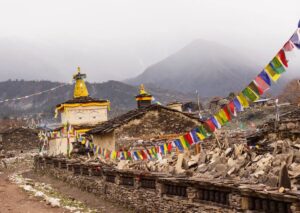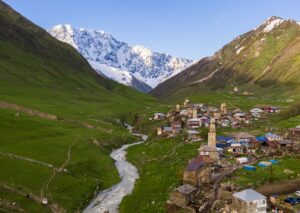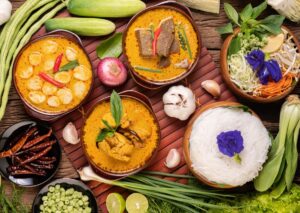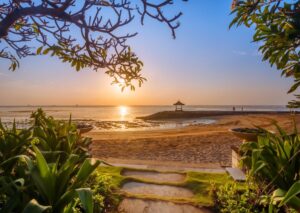Tucked away in the northern mountains of Thailand, Chiang Mai is a city that weaves together ancient history, lush landscapes, and a rich cultural tapestry. Known as the “Rose of the North,” this city is a haven for those looking to explore temples, nature, and Thai traditions. But beyond its well-trodden paths, Chiang Mai has been quietly transforming into a sustainable travel destination, offering eco-friendly accommodations, ethical tours, and an ever-growing commitment to preserving its natural and cultural heritage.
Having spent time immersing myself in the tranquility of Chiang Mai, I’ve seen first-hand how locals are adopting sustainable practices, from small family-run guesthouses to entire eco-tourism projects. Whether you’re into trekking through misty mountains, visiting ethical elephant sanctuaries, or simply soaking up the serenity of the temples, Chiang Mai offers a wealth of eco-friendly experiences. Let’s dive into how you can explore this incredible city sustainably!
Destination Overview

Nestled in the mountainous northern region of Thailand, Chiang Mai is the cultural heart of the Lanna Kingdom, dating back more than 700 years. The city’s fusion of modern and traditional life creates a unique charm—you’ll find ancient temples, night markets, and a growing collection of eco-conscious initiatives.
Chiang Mai’s lush surroundings make it the perfect destination for nature lovers and those seeking an escape from the busy streets of Bangkok. Whether you want to explore the serene countryside, visit elephant sanctuaries, or learn about the ancient traditions of hill tribes, Chiang Mai has it all. And the best part? You can do it all while keeping your carbon footprint low.
Why Chiang Mai is an Eco-Friendly Gem
Chiang Mai, with its centuries-old temples and rich traditions, is more than just a hub for culture and adventure—it’s also emerging as a leader in sustainable tourism. If you’re conscious about the environment but still want to experience authentic Thai culture, this is the place for you.
This post will guide you through the best eco-friendly stays, ethical attractions, and sustainable dining options in Chiang Mai. Together, we’ll uncover how you can enjoy the city while minimizing your environmental impact and supporting the local community.


Best Time to Visit: The best time to visit Chiang Mai is from November to February, when the weather is cool and pleasant, with average temperatures ranging from 15°C to 25°C (59°F to 77°F). This period is ideal for exploring the city’s outdoor attractions without the heat. However, if you’re looking to avoid the crowds, consider visiting during the shoulder season from March to May or September to October.
Getting There
Transportation Options: Chiang Mai International Airport (CNX) is well-connected to major cities around the world. You can book your flights through various airlines such as Thai Airways, Bangkok Airways, and low-cost carriers like AirAsia. For the best deals, click here to explore options.
Car Rental Information:
- DiscoverCars.com Agency: If you plan to explore the surrounding areas or prefer the freedom of driving, I highly recommend using DiscoverCars.com. This agency offers a wide range of vehicles at competitive prices and provides excellent customer service. They have everything from compact sedans to SUVs, ensuring you find the perfect vehicle for your needs.
- Why Choose DiscoverCars.com? They offer a hassle-free booking process, 24/7 customer support, and a wide selection of cars. Plus, they have a “Price Match Guarantee,” so you can be sure you’re getting the best deal.
- Tips for Renting a Car: When renting a car, make sure you have a valid driver’s license and check the vehicle’s condition before signing the agreement. Local regulations require you to wear a seatbelt at all times, and driving under the influence is strictly prohibited. Additionally, be aware of the local traffic rules and parking regulations.
Accommodation
Hotel Options:
- Budget Options: For budget-friendly accommodations, consider staying at Stamps Backpackers or Central Guesthouse, both of which offer comfortable rooms and a lively atmosphere. These hostels are great for meeting fellow travelers and getting insider tips on the best places to visit.
- Stamps Backpackers: Located in the heart of the old city, this hostel offers dorms and private rooms, a communal kitchen, and a cozy lounge area where you can swap stories with other travelers.
- Central Guesthouse: This family-run guesthouse provides a warm and welcoming environment with clean rooms and a delicious breakfast. It’s like staying with family!
- Luxury Options: If you’re looking for luxury, The Dhara Dhevi Chiang Mai and The Four Seasons Resort Chiang Mai provide top-notch amenities and stunning views.
- The Dhara Dhevi Chiang Mai: This resort is a masterpiece of Lanna architecture, offering luxurious villas, a spa, and multiple dining options. It’s the perfect place to unwind in style.
- The Four Seasons Resort Chiang Mai: Nestled in a lush valley, this resort features elegant rooms, a spa, and an array of outdoor activities. It’s a haven for those seeking luxury and tranquility.
- Unique Accommodations: For a more local experience, try staying at a hostel like Mad Monkey Hostel Chiang Mai or opt for an Airbnb in the old city area. These options allow you to live like a local and experience the authentic charm of Chiang Mai.
- Mad Monkey Hostel Chiang Mai: Known for its vibrant atmosphere, this hostel offers dorms and private rooms, a bar, and regular events. It’s the perfect place to meet new people and have some fun.
- Airbnb Options: Choose from a variety of apartments and houses in the old city, many of which are restored traditional Lanna houses. You’ll feel like you’re living in a piece of history.
Booking Tips: Always book your accommodations in advance, especially during peak season. Look for discounts and promotions on booking platforms like Booking.com or Agoda. Consider staying near key attractions to minimize travel time and maximize your experience. Some popular areas to stay include the old city, Nimmanhaemin (Nimman), and the riverside.
Main Attractions
Must-See Attractions:


- Wat Phra Singh: This temple is Chiang Mai’s most popular and houses a significant library. Its golden domes are typical of the Northern Thailand style, and it’s a great place to learn about Buddhist culture.
- Wat Chedi Luang: Known for its big chedi, this temple has an authentic architecture that hasn’t been redone, giving it a charming feel. It’s also home to the famous Emerald Buddha replica.
- Doi Inthanon National Park: This park offers stunning natural beauty, including waterfalls, hiking trails, and the highest peak in Thailand. It’s a must-visit for nature lovers and those seeking adventure.
Things to Do
Hidden Gems:


- Wat Phra Sri Suphan: This temple is a stunning beauty with aluminum and silver overlays, making it a unique visit. It’s less crowded than some of the more popular temples, offering a more serene experience.
- Free Bird Cafe: This cafe supports Burmese refugees and offers delicious vegan food in a lovely setting. It’s a great place to relax and contribute to a good cause. Check out Free Bird Cafe.
- Huay Tung Tao Lake: Located just outside the city, this lake offers a peaceful escape from the hustle and bustle. You can rent a boat, enjoy a picnic, or simply relax in the serene surroundings.
Itinerary
Here’s a sample 3-day itinerary to help you plan your trip:
Day 1:
- Morning: Visit the temples of the old city, including Wat Chiang Man, Wat Phra Singh, and Wat Chedi Luang. Start your day early to avoid the heat and crowds.
- Afternoon: Explore the Chiang Mai City Arts & Cultural Center to learn about the city’s history and culture.
- Evening: Visit the Chiang Mai Night Bazaar to try local street food and shop for souvenirs.
Day 2:
- Day Trip: Visit Wat Phra That Doi Suthep and Hmong Doi Pui Village. Enjoy the scenic views and learn about the local culture. This trip offers a mix of natural beauty and cultural insight.
- Tips for Day Trips: Pack snacks and water, wear comfortable shoes, and bring sunscreen. It’s also a good idea to hire a guide who can provide valuable insights into the local culture.
- Afternoon: Return to the city and visit Tha Phae Gate, one of the original gates of the old city. It’s a great spot for photos and offers a glimpse into the city’s history.
- Evening: Enjoy dinner at one of the local restaurants, such as The Riverside Bar & Restaurant, which offers stunning views of the Ping River.
Day 3:
- Day Trip: Head to Doi Inthanon National Park and explore the natural beauty. Visit the waterfalls, hiking trails, and the highest peak in Thailand. This trip is perfect for nature lovers and those seeking adventure.
- What to Expect: You’ll see breathtaking views, hike through lush forests, and maybe even spot some wildlife. Don’t forget your camera!
- Afternoon: Visit an elephant sanctuary in the afternoon. Elephant Nature Park is highly recommended for its ethical treatment of elephants and educational programs.
- Evening: Return to the city and enjoy a traditional Thai massage at one of the many spas, such as Fah Lanna Spa. It’s the perfect way to unwind after a busy day.
Tips for Maximizing Your Time:
- Plan your day trips in advance to avoid last-minute hassles.
- Use local transportation like Tuk-tuks or Songthaews to get around the city. These vehicles are affordable and offer a unique experience.
- Take breaks during the day to avoid the heat and enjoy the local cuisine.
- Consider hiring a guide for day trips to get the most out of your experience.
Local Culture and Cuisine


Local Cuisine: Chiang Mai is renowned for its vibrant food scene. Be sure to try local dishes like Khao Soi, a curried noodle soup; Sai Oua, a spicy Chiang Mai sausage; and Khanom Buang, Thai crepes. For a unique dining experience, visit The Riverside Bar & Restaurant, which offers stunning views of the Ping River.
Cultural Events: Chiang Mai hosts several cultural events throughout the year. The Loy Krathong festival, where lanterns are released into the sky, is a must-experience. The Songkran Water Festival is another significant event that celebrates the Thai New Year with water fights and traditional ceremonies.
If you’re in Chiang Mai, don’t miss out on a chance to dine like a local! Eatwith brings you right into the heart of Thai culture – straight to a local’s dinner table. This is how Chiang Mai really eats!
Practical Tips
Safety Tips:
- Always wear a helmet when riding a motorbike. Motorbike rentals are common, but safety should be your top priority.
- Why Wear a Helmet? It’s not just about following the law; it’s about protecting yourself from serious injury.
- Be cautious of your belongings in crowded areas. Pickpocketing can be a problem in tourist areas, so keep your valuables secure.
- Tips for Staying Safe: Keep your valuables close, avoid carrying large amounts of cash, and be mindful of your surroundings.
- Avoid traveling alone at night. While Chiang Mai is generally safe, it’s always better to be cautious.
Packing Tips:
- Pack light and breathable clothing. The weather in Chiang Mai can be hot and humid, so light fabrics are essential.
- What to Pack: Bring comfortable walking shoes, light clothing, sunscreen, and a hat.
- Bring sunscreen and a hat to protect yourself from the sun. The sun can be intense, especially during peak hours.
- Sun Protection: Don’t forget to reapply sunscreen regularly and wear protective clothing.
- Wear comfortable shoes for walking and hiking. Chiang Mai is a city best explored on foot, and comfortable shoes will make your experience much more enjoyable.
Language and Communication:
- Learn basic Thai phrases like “sawatdee” (hello) and “khop khun krap” (thank you). Locals appreciate when visitors make an effort to speak Thai.
- Why Learn Thai? It shows respect for the culture and can make your interactions more enjoyable.
- Download a translation app to help with communication. Apps like Google Translate can be very helpful when navigating the city.
Money and Currency:
- The local currency is the Thai Baht (THB). You can exchange currency at the airport, banks, or currency exchange shops.
- Where to Exchange Currency: Avoid exchanging money at airports or tourist areas where rates may not be favorable.
- Use Revolut for easy currency exchange and minimal fees. This app is a game-changer for travelers, offering real-time exchange rates and low transaction fees. It also allows you to withdraw cash from ATMs without high fees.
- Why Use Revolut? It’s convenient, cost-effective, and easy to use.
Practical Tips for Sustainable Tourism:
- Choose eco-friendly accommodations and tour operators. Look for certifications like the “Green Leaf” award, which indicates sustainable practices.
- Why Choose Eco-Friendly? It supports local communities and helps preserve the environment.
- Avoid single-use plastics and opt for reusable bags and water bottles. Chiang Mai has made significant strides in reducing plastic use, and your contribution can help.
- How to Reduce Plastic Use: Bring a reusable water bottle, use cloth bags for shopping, and avoid plastic straws.
- Support local businesses and communities. Visit local markets, eat at family-run restaurants, and support local artisans.
- Why Support Locals? It helps the local economy and provides a more authentic experience.
Stay Connected Anywhere:
- Use Yesim for seamless internet connectivity. This service provider offers affordable data plans and easy setup, ensuring you stay connected throughout your trip. With Yesim, you can navigate the city, stay in touch with friends and family, and access important information on the go.
- Why Choose Yesim? It’s convenient, affordable, and easy to set up.
Visa:
- Check if you need a visa to enter Thailand. For many nationalities, a visa on arrival or an e-visa is available. E-visa is an easy and quick electronic visa application service that can save you time and hassle at the airport.
- How to Apply for an E-Visa: The process is straightforward and can be completed online. It’s a great way to avoid long lines at the airport.
Chiang Mai is a city that will capture your heart with its unique blend of nature, culture, and modernity. From its ancient temples to its vibrant markets, and from its stunning natural beauty to its delicious local cuisine, there’s something for everyone here.
In this post, we’ve explored the best ways to experience Chiang Mai, from getting there and finding the right accommodations to discovering the city’s main attractions and hidden gems. We’ve also provided practical tips to ensure your trip is smooth and enjoyable.
Book your trip to Chiang Mai today and experience the magic of this enchanting city for yourself. Whether you’re a seasoned traveler or just starting your journey, Chiang Mai is a destination that will leave you with unforgettable memories.
For the best car rental deals, click here to explore options with DiscoverCars.com. And for seamless internet connectivity, check out Yesim Happy travels









